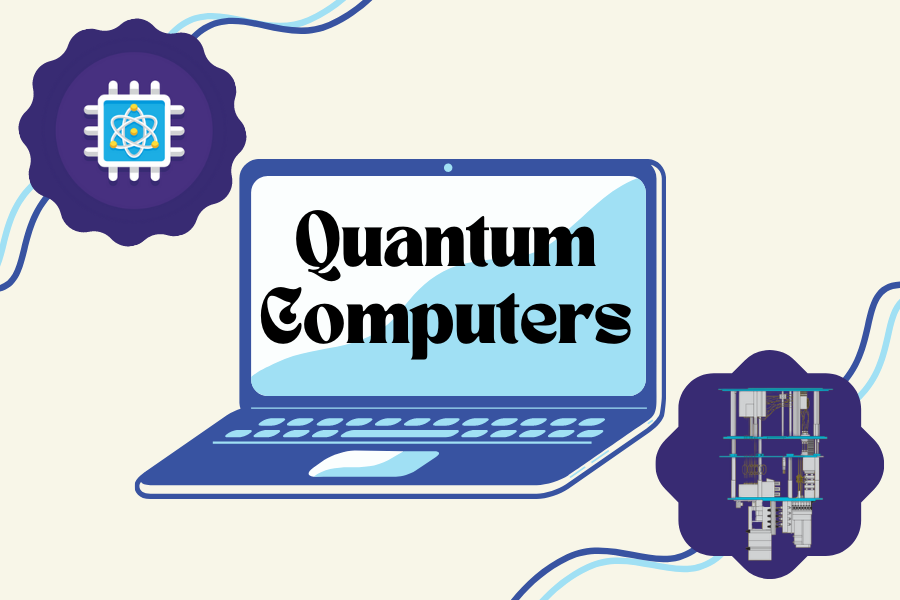Quantum Computers
Pharmaceutical drug formulation, fortified cybersecurity, maximum efficiency energy grids, and accurate weather forecasting are four seemingly random topics that are tied together by quantum computing. Quantum computing is a revolutionary kind of computing that utilizes quantum states and mechanics to perform calculations faster than even the largest supercomputers.
So what are quantum states? In essence, a quantum state is just a mathematical entity that provides a probability distribution for some kind of system. Expanding on quantum states, it is the quantum mechanic of superposition. Paul Dirac, theoretical physicist and Nobel laureate, explained that “ there exist peculiar relationships such that whenever the system is definitely in one state we can consider it as being partly in each of two or more other states.” In layman’s terms, Dirac was trying to explain that any quantum state can be represented by the sum of two or more other states or that combinations of quantum states also make a quantum state.
How do we make sense of these concepts when it comes to everyday life? To answer that question, I interviewed RK, a leading researcher in quantum computing in the realm of finance. RK explained that, “Typically we treat very small objects (like atoms, photons etc.) as quantum objects and human-sized objects (like balls, bridges, circuits etc.) as classical objects….when looking at a ball, you typically don’t care what each atom is doing, and you are happy to look at the average motion of all those atoms put together.”
No ordinary bit:
Computers that we use today process information in the form of bits. There are eight bits in a byte, one-thousand twenty-four bytes in a kilobyte, one-thousand twenty-four kilobytes in a megabyte and so on. You are most likely familiar with seeming downloads on computers labeled with MB, GB, or KB which stand for megabytes, gigabyte and kilobyte, respectively.
The mechanism by which quantum computers process information are qubits: an extremely creative shorthand for quantum bits. Qubits follow the mechanics of superposition. In physics or chemistry, you may have learned that light exists as both a particle and a wave. The way that a qubit can be described is as a light shining through a barrier with two slits. Some light goes through the top slit and some through the bottom which allows for the light waves to hit each other and create “interference” or distortion. If you examine the light more closely, you would see that it is in fact the light particles, photons, that are hitting each other. This makes it seem like each photon is just passing through a slit and not interfering, yet there is still a unique interference pattern that is created once the light passes through the barrier. This is the phenomenon known as superposition.
While a classical computer would navigate a maze or solve a puzzle in one way, the qubits in a supercomputer would travel all possible routes simultaneously. This is functionally equivalent to the interference that a light wave creates when passing through a slit in a barrier. The quantum computer is able to find optimal routes once the qubit “collapses” or is suspended in place. The collapse is the culmination of computation completed in the qubit’s state of superposition because it allows the quantum computer to find the most optimal path.
Applications:
If you equate the maze analogy to any function or encryption, then quantum computers are pretty powerful. Individual qubits exist in two states simultaneously, but because of the entanglement principle of quantum mechanics, each qubit added to the system increases the number of quantum states of a system exponentially. This means that each qubit makes the quantum computer an exponentially more potent problem-solving device. However, that doesn’t mean that classical computers will be obsolete. As RK indicated, “Some things will always be more efficient to do on a classical computer, e.g. if you want to add 2 numbers… Also, another subtle reason is that a classical device can copy its information, whereas quantum information cannot be copied.” But when tackling problems involving great degrees of uncertainty, quantum computation is the go-to tool. RK recently worked on applying quantum principles to derivative contracts, a type of paid agreement formed between two parties based on the value of a particular asset. Pricing these contracts often takes immense computing power because of the “uncertain” underlying value that an asset may possess in the future. Quantum computing has many more promising applications in the field of finance because of the potential to account for this “uncertain” value of a stock, index or other asset.
To Make a Qubit:
Qubits are really just a name for the concept of physically recreating superposition. IBM uses superconducting material like niobium and aluminum to create their qubits. In other cases, qubits are “made” through controlling electron spin via magnets and microwaves. In all cases, qubits are cooled using superfluids to reduce outside interference from the environment that may reduce the accuracy of the system.
Limitations:
The theoretical mechanisms behind quantum mechanics may be complex, but the physical system used to facilitate the complex algorithms presents a whole new hurdle for researchers to jump over. The main struggles of construction of an effective quantum computing device are called “scalability issues.” According to RK, these issues include “..getting more qubits into your device, trying to connect as many of these qubits together in your device and reducing the noise of your device (random, undesired variations).” Currently, IBM’s Eagle processor holds the record for the largest quantum computer with 127 qubits. That means that the processor can account for 2^127 quantum states if all qubits are working together simultaneously. Quantum computing is undeniably gaining more traction which is why RK is convinced that there may be commercial use for quantum computers in the next five to thirty years. Quantum computing could be the solution to all of our problems… or maybe not.
*NOTE: RK, the researcher interviewed for the article, has requested to not be named (and for their employer to not be named) for the sake of confidentiality despite the questions being rather trivial
Sources:
https://www.ibm.com/quantum-computing/what-is-quantum-computing/https://www.nature.com/articles/d41586-021-03476-5https://www.technologyreview.com/2019/01/29/66141/what-is-quantum-computing/https://quantum-computing.ibm.com/composer/docs/iqx/guide/the-qubit











